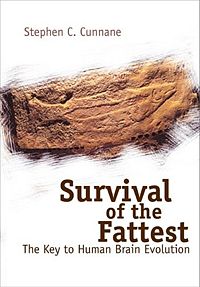Survival of the Fattest: Difference between revisions
imported>Brian R. Head No edit summary |
imported>Brian R. Head No edit summary |
||
| Line 1: | Line 1: | ||
{{subpages}} | {{subpages}} | ||
{{EZarticle}} | {{EZarticle}} | ||
'''THIS IS AN ACITVE STUDENT PROJECT THROUGH A SPECIAL UNIVERSITY OF COLORADO [[Sp08UniversityofColoradoatBoulderANTH4110HumanEvolutionaryBiology|Project]] PLEASE REFRAIN FROM EDITING. THANK YOU''' | |||
[[Image:Cunnane Book Cover.jpg|thumb|200 px|Author: [[Stephen C. Cunnane]] | [[Image:Cunnane Book Cover.jpg|thumb|200 px|Author: [[Stephen C. Cunnane]] | ||
----Published: 2005 | ----Published: 2005 | ||
----Published By: [[World Scientific]] ]] | ----Published By: [[World Scientific]] ]] | ||
'''''Survival of the Fattest: The Key to Human Brain Evolution''''' was written by [[Stephen C. Cunnane]]. The book outlines why fat babies are important to human brain evolution and the ecological circumstances that allowed for fat babies to evolve. Cunnane details the specific nutrients that are important for human brain growth and function and explains the ways in which they work. Cunnane also presents a theory called the [[Shore-Based Scenario]] to explain where ancient hominids obtained these nutrients. | '''''Survival of the Fattest: The Key to Human Brain Evolution''''' was written by [[Stephen C. Cunnane]]. The book outlines why fat babies are important to human brain evolution and the ecological circumstances that allowed for fat babies to evolve. Cunnane details the specific nutrients that are important for human brain growth and function and explains the ways in which they work. Cunnane also presents a theory called the [[Shore-Based Scenario]] to explain where ancient hominids obtained these nutrients. | ||
==Synopsis== | |||
===The Human Brain=== | |||
Cunnane begins by explaining the similarities of all animal brains. [[Homeobox|Hox]] genes control the traits of brains for almost all animal species. Similar to all primates, humans don’t show a specific genetic advantage for brain growth while in the early stages of embryonic development. <ref name=Cunnane 2005.>Cunnane, Stephen C. Survival of the Fattest: The Key to Hominid Brain Evolution.</ref> He describes the uniqueness of the human brain as having low resistance to damage, low functionality at birth, yet being incredibly vulnerable and needing a constant energy supply to develop normally. The newborn infant brain uses about 74% of the energy consumed by the entire body. <ref name=Holliday 1971.> Holliday M. Metabolic rate and organ size during growth from infancy to maturity during late gestation and early infancy. ''Pediatrics'' 47, 169-172, 1971.</ref> | |||
==References== | |||
<references/> | |||
Revision as of 16:09, 16 March 2008
THIS IS AN ACITVE STUDENT PROJECT THROUGH A SPECIAL UNIVERSITY OF COLORADO Project PLEASE REFRAIN FROM EDITING. THANK YOU
Survival of the Fattest: The Key to Human Brain Evolution was written by Stephen C. Cunnane. The book outlines why fat babies are important to human brain evolution and the ecological circumstances that allowed for fat babies to evolve. Cunnane details the specific nutrients that are important for human brain growth and function and explains the ways in which they work. Cunnane also presents a theory called the Shore-Based Scenario to explain where ancient hominids obtained these nutrients.
Synopsis
The Human Brain
Cunnane begins by explaining the similarities of all animal brains. Hox genes control the traits of brains for almost all animal species. Similar to all primates, humans don’t show a specific genetic advantage for brain growth while in the early stages of embryonic development. Cite error: Invalid <ref> tag; invalid names, e.g. too many He describes the uniqueness of the human brain as having low resistance to damage, low functionality at birth, yet being incredibly vulnerable and needing a constant energy supply to develop normally. The newborn infant brain uses about 74% of the energy consumed by the entire body. Cite error: Invalid <ref> tag; invalid names, e.g. too many
